The AMD Threadripper 2990WX 32-Core and 2950X 16-Core Review
by Dr. Ian Cutress on August 13, 2018 9:00 AM ESTHEDT Benchmarks: Web and Legacy Tests
While more the focus of low-end and small form factor systems, web-based benchmarks are notoriously difficult to standardize. Modern web browsers are frequently updated, with no recourse to disable those updates, and as such there is difficulty in keeping a common platform. The fast paced nature of browser development means that version numbers (and performance) can change from week to week. Despite this, web tests are often a good measure of user experience: a lot of what most office work is today revolves around web applications, particularly email and office apps, but also interfaces and development environments. Our web tests include some of the industry standard tests, as well as a few popular but older tests.
We have also included our legacy benchmarks in this section, representing a stack of older code for popular benchmarks.
WebXPRT 3: Modern Real-World Web Tasks, including AI
The company behind the XPRT test suites, Principled Technologies, has recently released the latest web-test, and rather than attach a year to the name have just called it ‘3’. This latest test (as we started the suite) has built upon and developed the ethos of previous tests: user interaction, office compute, graph generation, list sorting, HTML5, image manipulation, and even goes as far as some AI testing.
For our benchmark, we run the standard test which goes through the benchmark list seven times and provides a final result. We run this standard test four times, and take an average.
Users can access the WebXPRT test at http://principledtechnologies.com/benchmarkxprt/webxprt/
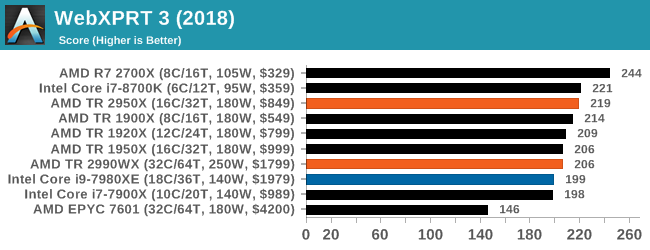
WebXPRT 2015: HTML5 and Javascript Web UX Testing
The older version of WebXPRT is the 2015 edition, which focuses on a slightly different set of web technologies and frameworks that are in use today. This is still a relevant test, especially for users interacting with not-the-latest web applications in the market, of which there are a lot. Web framework development is often very quick but with high turnover, meaning that frameworks are quickly developed, built-upon, used, and then developers move on to the next, and adjusting an application to a new framework is a difficult arduious task, especially with rapid development cycles. This leaves a lot of applications as ‘fixed-in-time’, and relevant to user experience for many years.
Similar to WebXPRT3, the main benchmark is a sectional run repeated seven times, with a final score. We repeat the whole thing four times, and average those final scores.
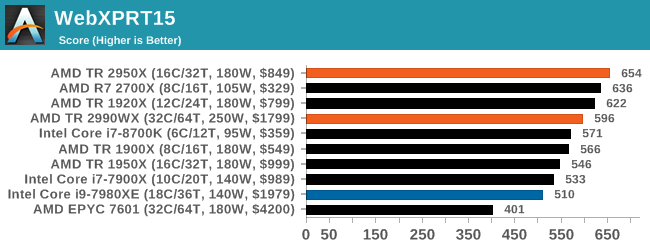
Speedometer 2: Javascript Frameworks
Our newest web test is Speedometer 2, which is a accrued test over a series of javascript frameworks to do three simple things: built a list, enable each item in the list, and remove the list. All the frameworks implement the same visual cues, but obviously apply them from different coding angles.
Our test goes through the list of frameworks, and produces a final score indicative of ‘rpm’, one of the benchmarks internal metrics. We report this final score.
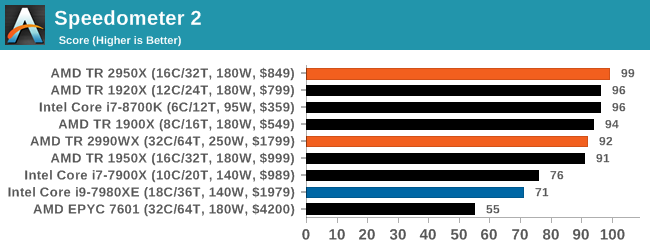
Google Octane 2.0: Core Web Compute
A popular web test for several years, but now no longer being updated, is Octane, developed by Google. Version 2.0 of the test performs the best part of two-dozen compute related tasks, such as regular expressions, cryptography, ray tracing, emulation, and Navier-Stokes physics calculations.
The test gives each sub-test a score and produces a geometric mean of the set as a final result. We run the full benchmark four times, and average the final results.

Mozilla Kraken 1.1: Core Web Compute
Even older than Octane is Kraken, this time developed by Mozilla. This is an older test that does similar computational mechanics, such as audio processing or image filtering. Kraken seems to produce a highly variable result depending on the browser version, as it is a test that is keenly optimized for.
The main benchmark runs through each of the sub-tests ten times and produces an average time to completion for each loop, given in milliseconds. We run the full benchmark four times and take an average of the time taken.
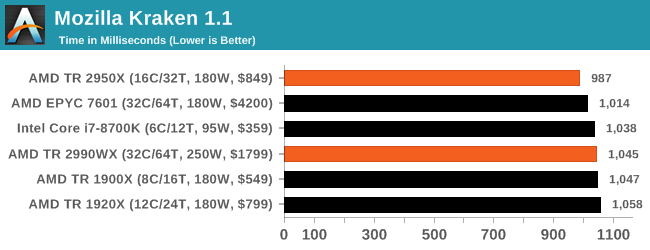
3DPM v1: Naïve Code Variant of 3DPM v2.1
The first legacy test in the suite is the first version of our 3DPM benchmark. This is the ultimate naïve version of the code, as if it was written by scientist with no knowledge of how computer hardware, compilers, or optimization works (which in fact, it was at the start). This represents a large body of scientific simulation out in the wild, where getting the answer is more important than it being fast (getting a result in 4 days is acceptable if it’s correct, rather than sending someone away for a year to learn to code and getting the result in 5 minutes).
In this version, the only real optimization was in the compiler flags (-O2, -fp:fast), compiling it in release mode, and enabling OpenMP in the main compute loops. The loops were not configured for function size, and one of the key slowdowns is false sharing in the cache. It also has long dependency chains based on the random number generation, which leads to relatively poor performance on specific compute microarchitectures.
3DPM v1 can be downloaded with our 3DPM v2 code here: 3DPMv2.1.rar (13.0 MB)

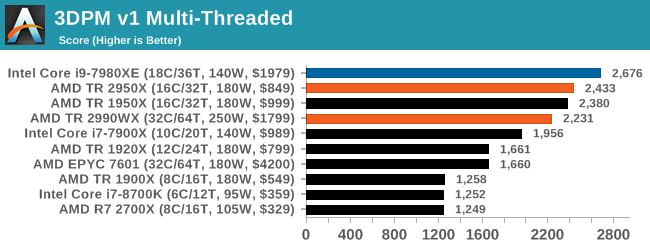
x264 HD 3.0: Older Transcode Test
This transcoding test is super old, and was used by Anand back in the day of Pentium 4 and Athlon II processors. Here a standardized 720p video is transcoded with a two-pass conversion, with the benchmark showing the frames-per-second of each pass. This benchmark is single-threaded, and between some micro-architectures we seem to actually hit an instructions-per-clock wall.
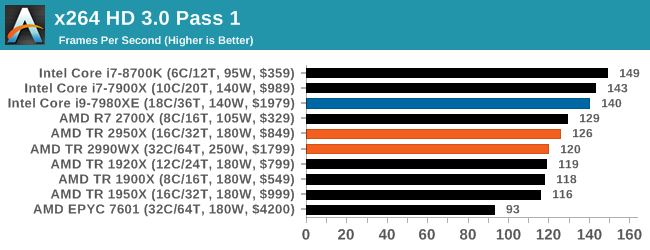
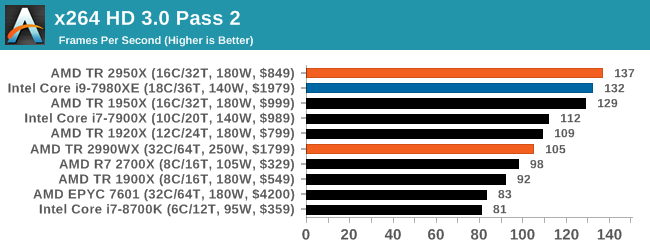










171 Comments
View All Comments
MrSpadge - Monday, August 13, 2018 - link
I don't think AVX512 is going to matter much anytime soon. However, The 8 memory channels of EPYC could matter a lot for HPC.ElFenix - Monday, August 13, 2018 - link
You guys need a 4k or maybe even 5k workload for transcoding - it's thread limited at 1080p so it becomes IPC and turbo limited. With x265 you can load up multiple 1080p handbrake instances on these high core count processors and they don't break a sweat.ElFenix - Monday, August 13, 2018 - link
That should be *1080p spawns limited numbers of threads*T1beriu - Monday, August 13, 2018 - link
>Europe is famed for its lack of air conditioning everywhereUK is a lot colder generally in the summer compared to the rest of Europe. I wouldn't generalize the lack of AC for the rest of Europe. AC is pretty common in my country.
jospoortvliet - Saturday, August 18, 2018 - link
Missing everywhere here in Germany... though after this insanely hot summer i bet that that will begin to change...powerincarnate - Monday, August 13, 2018 - link
I didn't see a lot of gaming benchmarks, which I guess I understand, since these are more workstation cpus. It would be good to have seen both though to get a better idea of the overall qualities of the cpu as a multipurpose care.It seems from tomshardware benches that 7980xe, especially when overclocked, is best overall. AMD 2990wx obviously winning on the pure multi-threaded workstation stuff as long as it is not memory intensive.
It seems like the 2950x from both of these sites, is really the processor to get from the threadripper lineup.
it seems when gaming is taken to account, the best of both worlds is the 7900x
And for gaming, and when you factor price as well, the 8700k, 8086, and slightly behind, the 2700x are the cards to get.
Overall.... I'm a little disappointed in this release. Was much more impressed with the 2700x. It's likely since we didn't really get a true change in the manufacturing process or design of the chip, that the limitations of the 2990wx will probably be ironed out with Zen2 (this is Zen+ after all).
bill.rookard - Monday, August 13, 2018 - link
Looking at it myself, yeah - these really aren't gaming CPUs by any stretch of the imagination, thus the lack of gaming benchmarks is perfectly understandable to me. As for the results of the benchmark results? I'm thinking the 2950x is the sweet spot. Lower power, lower latency, more power for the cores vs interconnects, and a much higher clockspeed makes it IMHO the better choice unless you have those fringe workloads which requires a bunch-o-cores.shendxx - Monday, August 13, 2018 - link
this guy come from Toms that said 7900x is best for both world, lol, when the graph from toms show clearly even on gaming, 2950x is equal on Minimum FPS with 8700k and only lose 3 to 10 FPS On Average,apoclypse - Monday, August 13, 2018 - link
I don't know. Gaming performance is the least thing I care about with this chip but that seems be all most tech press cares about, especially tech tubers. These chips are not for gaming. If anything these chips should be compared to Intel's Xeon line as it seems that is actually where AMD is aiming these at since they don't have a dedicated SKU for workstation chips like Intel. These are only marketed as HEDT chips because it gives AMD positive press, but if anything the ones who should be paying attention should be OEM high end workstation builders. In that regard Threadripper is more than compelling. It's higher clocked than Intel's Xeon chips, has more cores for less money, and still has all the pro level features that is needed for workstation level work.I think AMD should lean into that a bit more in their marketing but that stuff isn't sexy and it doesn't grab attention like marketing it towards rich and stupid "gamers", and the technorati who eat that stuff up.
This is a workstation chip period, and should be treated, tested and benchmarked as such, imo.
Icehawk - Monday, August 13, 2018 - link
If only the tier 1 vendors would offer TR workstations... I really wanted to purchase a few for work to use as VM hosts but my only real option is Xeon currently. The 32 core monster would likely make for a great VM host for mid-weight usage.